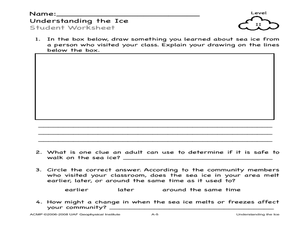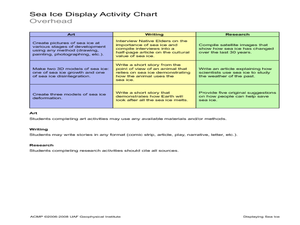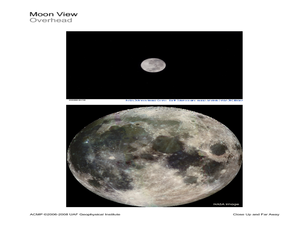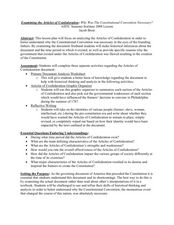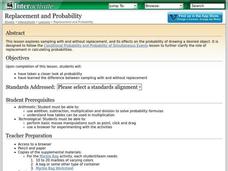Curated OER
Permafrost
Students use a thermometer to analyze soil temperature data to determine which soil sample is normal, and which one is permafrost. In this permafrost lesson plan, students participate in a hands on activity where they identify the active...
Curated OER
Layering the Soil
Students study and classify soil. In this soil science instructional activity, students classify soil by texture and size and study soil horizons. Students label the soil types with their specific soil horizon and learn about permafrost....
Curated OER
Collecting Compost
Students observe a composting box. In this soil lesson, students create a composting bin by using a bin, newspaper, worms, and food scraps. Students create a composting food web.
Curated OER
Understanding the Ice
Learners explore the concept of sea ice. In this sea ice lesson, students interview arctic hunters to regarding the sea ice safety and attributes.
Curated OER
Displaying Sea Ice
Learners display their knowledge of sea ice. In this earth science lesson, students create displays reflecting their understanding of sea ice.Learners research the development of sea ice on a variety of bodies of...
Curated OER
The Water Cycle Game
Learners study the path and forms of water through Earth. In this water cycle lesson, students role-play water as it moves throughout the Earth. Learners play the water cycle game and complete various stations to learn about water forms...
Curated OER
Sea Ice and Satellites
Learners study satellites and satellite images using Google Earth. In this satellite instructional activity, students discuss satellites and how they work. Learners watch a demonstration of how satellites work and learn what they are...
Curated OER
Close Up and Far Away
Students use magnifiers and telescopes to view things close up. In this magnifiers and telescopes lesson plan, students use the tools to identify things that are close and far away. Students tell details of things they can see closer.
Curated OER
Japanese Poetry: Tanka? You're Welcome!
Students analyze Japanese tanka poetry. In this Japanese poetry lesson, students identify analyze the structure of tanka poetry. Students complete the activities at the given links for the lesson and compose two tanka poems.
Curated OER
Digging It - A Garden That Is
Students plan, design, and create a school/community garden. In this planning, designing, and creating a school/community garden lesson, students research materials needed to start a garden. Students determine the cost of...
Curated OER
Design a Latin American Restaurant
Learners investigate the culture of a Latin American country to design a new restaurant. In this Latin American lesson, students identify social classes, geographical locations, cultural practices, and monetary systems of a Latin...
Curated OER
Wind Power: From Eyesore to Energy
Students design their own wind turbine according to client's needs. In this science and technology lesson, students analyze the pros and cons of using wind power. They construct a model of their proposed wind turbine and present it to...
Curated OER
Critical Analysis Leads to Global Action
Students discover the interconnectedness of the world. For this global studies lesson, students identify challenges the world faces and craft solutions to the problems they identified. Students present their findings in a PowerPoint...
Curated OER
Why was the Constitutional Convention Necessary?
Eleventh graders explore the steps leading up to the Constitution. In this American Government lesson, 11th graders practice document based questions. Students create a letter that describes how a person felt during this...
Curated OER
LBJ-- Escalation in Vietnam and Domestic Programs
Eighth graders investigate the Vietnam War. In this Vietnam War lesson, 8th graders research the escalation of the war during Lyndon Johnson's presidency. Students also explore the domestic programs that Johnson promoted. Students...
Curated OER
Classification of Animals
Middle schoolers identify observable features of eight dinosaurs and create a sorting chart using SMART Notebook on a SMART Board (or, in case you do not have a SMART Board, a chalk or dry-erase board).
Curated OER
Persuasive Elements
Investigate letters to the editor and their persuasive qualities. Break your class into reading groups and give each one a different article. As they read, they complete a graphic organizer to record their thoughts and opinions. There is...
Curated OER
Mr. Lincoln's Whiskers
Learn about the events that helped shape the United States of America. Elementary schoolers explore the Civil War with six different activities. Each activity has a different focus: literature connections, primary sources, vocabulary,...
Curated OER
The Case of the "Lost Gorge:
Learners examine the case of a map making expedition. In groups, they read a case study on "The Lost Gorge" in the Finger Lakes region of New York state. They examine maps and determine where the error in the map-making occured to end...
Curated OER
Prairie Scales and Prairie Smoothies
Sixth graders explore the animals that live on the prairie and identify differences between amphibians and reptiles and the adaptations each have made to live on the prairie.
Curated OER
Wreck Detectives
Junior archaeologists examine types of artifacts from the Bronze Age on the internet. In collaborative groups, they create a story about a ship from this period and then construct a model of the ocean floor after their ship has sunk....
Curated OER
Endangered Species
Ninth graders graph data in order to compare the number of extinct species and a rise in human population. They analyze the data collected. Students are encouraged to infer the relationship.
Shodor Education Foundation
Introduction to the Concept of Probability
Acquaint mathematicians to the concept of probability with a discussion about the results of a game. Then have them play a dice, card, spinner, or coin game and recording the number of wins vs. the number of tries on an interactive web...
Shodor Education Foundation
Replacement and Probability
Middle and high schoolers explore the concept of probability. In this probability instructional activity, learners conduct an experiment with a bag of marbles. Pupils draw marbles from a bag and determine the probability of drawing a...





